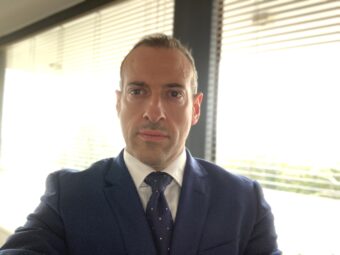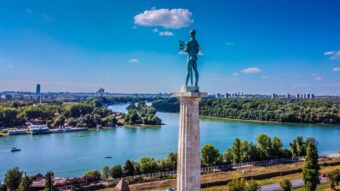
More than 30 years ago, an international financial institution was established in the British capital, whose main goal was to support the transition from a centrally planned economy to an open market and democracy in the countries of Central and Eastern Europe after the fall of the Berlin Wall. This institution, whose name is European and capital mostly American, is still considered a major investor in the private and public sector in 38 countries in Europe and Asia.
The European Bank for Reconstruction and Development started the first program in our country through assistance to FR Yugoslavia in 2001. Francesco Corbo, Regional Head Energy Europe for Western Balkans and Croatia at EBRD, told us about the EBRD’s priorities today compared to those two decades ago and what has changed in the EBRD’s operations in this area.
EP: It has been announced that from the end of 2022, all EBRD activity will be aligned with one aim: to help countries meet their goals under the Paris Agreement. It sounds like a huge volume of work. What does this actually comprise?
Francesco Corbo: The EBRD Climate Ambition Resolution includes the commitment to align all Bank activities with the objectives of the Paris Agreement by 2022. The Bank is assessing its direct and indirect investments for Paris alignment using methodologies developed jointly with other MDBs. In a nutshell, a project must meet several conditions to be determined as Paris aligned: consistency with a long-term low-carbon development strategy, a low likelihood of carbon lock-in – to give assurance that the project does not enable an emissions-intensive asset to continue operating when economically viable lower-carbon options could replace it, physical climate risks have been identified and addressed, and the activities do not undermine climate resilience in the local context.
The EBRD has been supporting its COO efforts to develop their low-carbon and climate-resilient policy roadmaps at the economy-wide and sectoral levels. Additionally, we work with clients to help them assess climate risks and to integrate climate resilience considerations into their operations.
EP: Many cities have joined the EBRD programme Green Cities, Belgrade and Skoplje among them. What can you tell us about the support the cities are getting through this programme, and when do you expect the results to be visible to their citizens?
Francesco Corbo: EBRD Green Cities is an initiative which supports cities to identify and plan priority investments that can help them become more sustainable, resilient and, in general, improve the quality of the environment. Participating cities receive assistance from the EBRD in developing feasibility studies, following which they can consider which projects should be their priority investment in the future. The EBRD and donors provide financing for these investments, and there have been lots of developments in the region. For example, in Sarajevo, as part of this programme, we financed energy efficiency improvements in public buildings, new electric trolleybuses, upgrade of water and sewerage network etc. These are the projects where citizens can see obvious results with better services of public utility companies, improved quality of air etc.
In focus:
EP: The EBRD has a certain fund for investments in green energy transition projects. What does this portfolio include? Is it more energy efficiency or renewable energy sources inclined to?
Francesco Corbo: Green energy transition projects cannot happen without enabling policies. We work with all governments in the region to strengthen their energy sector policy frameworks and align them with relevant EU Directives. On renewables, we are working in Albania, Montenegro, Kosovo*, North Macedonia and Serbia to introduce renewable auctions, helping policy-makers design and implement competitive bidding schemes that will aim to add up to more than 1GW of solar and wind capacity once implemented.

A key principle of EBRD support is that the framework needs to be replicable and scalable – therefore, the EBRD is not just supporting the first 100 MW project but laying the foundation for the first 1,000 or even 10,000 MW. Some results are beginning to come in as our first solar auction for 140MW in Albania, which yielded a price of below 25 EUR/MWh, with bids opened during the first wave of the pandemic in May 2020. This result sent a strong signal to other countries in the region, and the success was replicated when Albania concluded a follow-up solar PV auction in March last year.
And under the Regional Energy Efficiency Programme, REEP, we have delivered in total more than 75 policy products that promote energy efficiency markets. Most of these policies refer to improving energy performance in buildings. The building sector accounts for over 40 percent of total energy consumption in the Western Balkans, and renovating public and private buildings to meet minimum energy performance standards can make a very significant contribution to national decarbonisation goals. Such works also directly improve the living standards of citizens.
EP: The EBRD has invested more than EUR 6.6 billion across 286 projects in the country to date. Would you say it has been a success for one institutional investor so far, and please highlight some of the projects that could be considered the ones that have brought the most benefits?
Francesco Corbo: To date, the EBRD has invested over EUR 7.3 billion in Serbia in close to 300 projects since 2001. The impact of our investments is visible in a stronger banking sector and better access to finance for SMEs, in the stronger private sector and local corporates that we supported to become regional champions and brands, like MK Group or Bambi, Knjaz Miloš and Nektar, in hundreds of women-led businesses that we supported with finance and advisory. We also contributed to better roads and railway connectivity which we supported with our partners EU and WBIF, better wastewater infrastructure in Subotica and urban transport in Belgrade and Novi Sad, to name only a few examples. More recently, we support Serbia’s efforts to improve waste management infrastructure, which is a sector that has been neglected for years. We finance the construction of the new landfill in Vinča and waste-to-energy plant, as well as several regional landfills across the country. This will help build modern waste management infrastructure in the country and provide new services to citizens, encouraging them to sort and recycle household waste.
Interviewed by: Nevena Đukić
Read the story in the new issue of the Energy portal Magazine RENEWABLE ENERGY SOURCES.



